
CogVideo
text and image to video generation: CogVideoX (2024) and CogVideo (ICLR 2023)
Stars: 11017
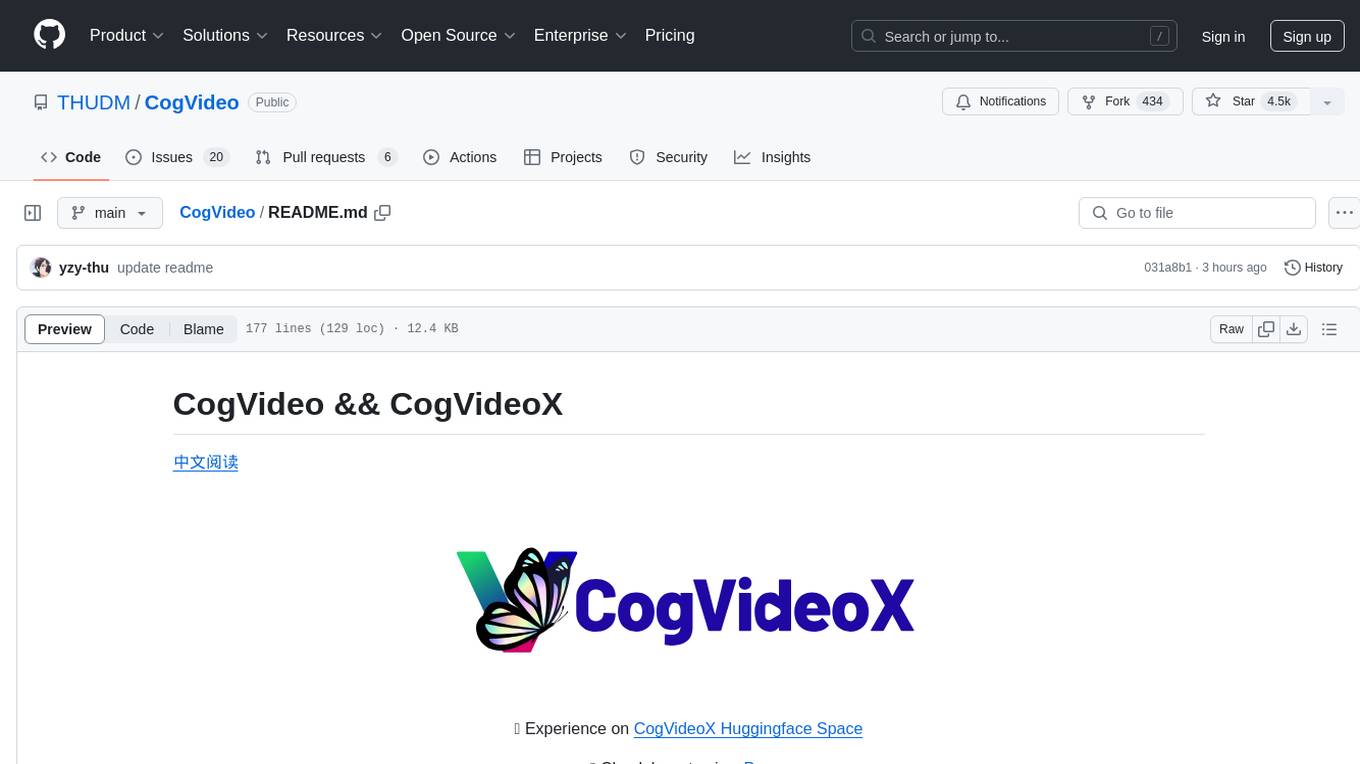
CogVideo is an open-source repository that provides pretrained text-to-video models for generating videos based on input text. It includes models like CogVideoX-2B and CogVideo, offering powerful video generation capabilities. The repository offers tools for inference, fine-tuning, and model conversion, along with demos showcasing the model's capabilities through CLI, web UI, and online experiences. CogVideo aims to facilitate the creation of high-quality videos from textual descriptions, catering to a wide range of applications.
README:
Experience the CogVideoX-5B model online at 🤗 Huggingface Space or 🤖 ModelScope Space
📚 View the paper and user guide
📍 Visit QingYing and API Platform to experience larger-scale commercial video generation models.
- 🔥 News:
2025/02/28: DDIM Inverse is now supported inCogVideoX-5BandCogVideoX1.5-5B. Check here. - 🔥 News:
2025/01/08: We have updated the code forLorafine-tuning based on thediffusersversion model, which uses less GPU memory. For more details, please see here. - 🔥 News:
2024/11/15: We released theCogVideoX1.5model in the diffusers version. Only minor parameter adjustments are needed to continue using previous code. - 🔥 News:
2024/11/08: We have released the CogVideoX1.5 model. CogVideoX1.5 is an upgraded version of the open-source model CogVideoX. The CogVideoX1.5-5B series supports 10-second videos with higher resolution, and CogVideoX1.5-5B-I2V supports video generation at any resolution. The SAT code has already been updated, while the diffusers version is still under adaptation. Download the SAT version code here. - 🔥 News:
2024/10/13: A more cost-effective fine-tuning framework forCogVideoX-5Bthat works with a single 4090 GPU, cogvideox-factory, has been released. It supports fine-tuning with multiple resolutions. Feel free to use it! - 🔥 News:
2024/10/10: We have updated our technical report. Please click here to view it. More training details and a demo have been added. To see the demo, click here.- 🔥 News:2024/10/09: We have publicly released the technical documentation for CogVideoX fine-tuning on Feishu, further increasing distribution flexibility. All examples in the public documentation can be fully reproduced. - 🔥 News:
2024/9/19: We have open-sourced the CogVideoX series image-to-video model CogVideoX-5B-I2V. This model can take an image as a background input and generate a video combined with prompt words, offering greater controllability. With this, the CogVideoX series models now support three tasks: text-to-video generation, video continuation, and image-to-video generation. Welcome to try it online at Experience. - 🔥
2024/9/19: The Caption model CogVLM2-Caption, used in the training process of CogVideoX to convert video data into text descriptions, has been open-sourced. Welcome to download and use it. - 🔥
2024/8/27: We have open-sourced a larger model in the CogVideoX series, CogVideoX-5B. We have significantly optimized the model's inference performance, greatly lowering the inference threshold. You can run CogVideoX-2B on older GPUs likeGTX 1080TI, and CogVideoX-5B on desktop GPUs likeRTX 3060. Please strictly follow the requirements to update and install dependencies, and refer to cli_demo for inference code. Additionally, the open-source license for the CogVideoX-2B model has been changed to the Apache 2.0 License. - 🔥
2024/8/6: We have open-sourced 3D Causal VAE, used for CogVideoX-2B, which can reconstruct videos with almost no loss. - 🔥
2024/8/6: We have open-sourced the first model of the CogVideoX series video generation models, **CogVideoX-2B **. - 🌱 Source:
2022/5/19: We have open-sourced the CogVideo video generation model (now you can see it in theCogVideobranch). This is the first open-source large Transformer-based text-to-video generation model. You can access the ICLR'23 paper for technical details.
Jump to a specific section:
- Quick Start
- Gallery
- Model Introduction
- Friendly Links
- Project Structure
- CogVideo(ICLR'23)
- Citation
- Model-License
Before running the model, please refer to this guide to see how we use large models like GLM-4 (or other comparable products, such as GPT-4) to optimize the model. This is crucial because the model is trained with long prompts, and a good prompt directly impacts the quality of the video generation.
Please make sure your Python version is between 3.10 and 3.12, inclusive of both 3.10 and 3.12.
Follow instructions in sat_demo: Contains the inference code and fine-tuning code of SAT weights. It is recommended to improve based on the CogVideoX model structure. Innovative researchers use this code to better perform rapid stacking and development.
Please make sure your Python version is between 3.10 and 3.12, inclusive of both 3.10 and 3.12.
pip install -r requirements.txt
Then follow diffusers_demo: A more detailed explanation of the inference code, mentioning the significance of common parameters.
For more details on quantized inference, please refer to diffusers-torchao. With Diffusers and TorchAO, quantized inference is also possible leading to memory-efficient inference as well as speedup in some cases when compiled. A full list of memory and time benchmarks with various settings on A100 and H100 has been published at diffusers-torchao.
To view the corresponding prompt words for the gallery, please click here
CogVideoX is an open-source version of the video generation model originating from QingYing. The table below displays the list of video generation models we currently offer, along with their foundational information.
| Model Name | CogVideoX1.5-5B (Latest) | CogVideoX1.5-5B-I2V (Latest) | CogVideoX-2B | CogVideoX-5B | CogVideoX-5B-I2V |
|---|---|---|---|---|---|
| Release Date | November 8, 2024 | November 8, 2024 | August 6, 2024 | August 27, 2024 | September 19, 2024 |
| Video Resolution | 1360 * 768 | Min(W, H) = 768 768 ≤ Max(W, H) ≤ 1360 Max(W, H) % 16 = 0 |
720 * 480 | ||
| Number of Frames | Should be 16N + 1 where N <= 10 (default 81) | Should be 8N + 1 where N <= 6 (default 49) | |||
| Inference Precision | BF16 (Recommended), FP16, FP32, FP8*, INT8, Not supported: INT4 | FP16*(Recommended), BF16, FP32, FP8*, INT8, Not supported: INT4 | BF16 (Recommended), FP16, FP32, FP8*, INT8, Not supported: INT4 | ||
| Single GPU Memory Usage |
SAT BF16: 76GB diffusers BF16: from 10GB* diffusers INT8(torchao): from 7GB* |
SAT FP16: 18GB diffusers FP16: 4GB minimum* diffusers INT8 (torchao): 3.6GB minimum* |
SAT BF16: 26GB diffusers BF16 : 5GB minimum* diffusers INT8 (torchao): 4.4GB minimum* |
||
| Multi-GPU Memory Usage |
BF16: 24GB* using diffusers |
FP16: 10GB* using diffusers |
BF16: 15GB* using diffusers |
||
| Inference Speed (Step = 50, FP/BF16) |
Single A100: ~1000 seconds (5-second video) Single H100: ~550 seconds (5-second video) |
Single A100: ~90 seconds Single H100: ~45 seconds |
Single A100: ~180 seconds Single H100: ~90 seconds |
||
| Prompt Language | English* | ||||
| Prompt Token Limit | 224 Tokens | 226 Tokens | |||
| Video Length | 5 seconds or 10 seconds | 6 seconds | |||
| Frame Rate | 16 frames / second | 8 frames / second | |||
| Position Encoding | 3d_rope_pos_embed | 3d_sincos_pos_embed | 3d_rope_pos_embed | 3d_rope_pos_embed + learnable_pos_embed | |
| Download Link (Diffusers) |
🤗 HuggingFace 🤖 ModelScope 🟣 WiseModel |
🤗 HuggingFace 🤖 ModelScope 🟣 WiseModel |
🤗 HuggingFace 🤖 ModelScope 🟣 WiseModel |
🤗 HuggingFace 🤖 ModelScope 🟣 WiseModel |
🤗 HuggingFace 🤖 ModelScope 🟣 WiseModel |
| Download Link (SAT) |
🤗 HuggingFace 🤖 ModelScope 🟣 WiseModel |
SAT | |||
Data Explanation
- While testing using the diffusers library, all optimizations included in the diffusers library were enabled. This scheme has not been tested for actual memory usage on devices outside of NVIDIA A100 / H100 architectures. Generally, this scheme can be adapted to all NVIDIA Ampere architecture and above devices. If optimizations are disabled, memory consumption will multiply, with peak memory usage being about 3 times the value in the table. However, speed will increase by about 3-4 times. You can selectively disable some optimizations, including:
pipe.enable_sequential_cpu_offload()
pipe.vae.enable_slicing()
pipe.vae.enable_tiling()
- For multi-GPU inference, the
enable_sequential_cpu_offload()optimization needs to be disabled. - Using INT8 models will slow down inference, which is done to accommodate lower-memory GPUs while maintaining minimal video quality loss, though inference speed will significantly decrease.
- The CogVideoX-2B model was trained in
FP16precision, and all CogVideoX-5B models were trained inBF16precision. We recommend using the precision in which the model was trained for inference. -
PytorchAO and Optimum-quanto can be
used to quantize the text encoder, transformer, and VAE modules to reduce the memory requirements of CogVideoX. This
allows the model to run on free T4 Colabs or GPUs with smaller memory! Also, note that TorchAO quantization is fully
compatible with
torch.compile, which can significantly improve inference speed. FP8 precision must be used on devices with NVIDIA H100 and above, requiring source installation oftorch,torchaoPython packages. CUDA 12.4 is recommended. - The inference speed tests also used the above memory optimization scheme. Without memory optimization, inference speed
increases by about 10%. Only the
diffusersversion of the model supports quantization. - The model only supports English input; other languages can be translated into English for use via large model refinement.
We highly welcome contributions from the community and actively contribute to the open-source community. The following works have already been adapted for CogVideoX, and we invite everyone to use them:
-
RIFLEx-CogVideoX:
RIFLEx extends the video with just one line of code:
freq[k-1]=(2np.pi)/(Ls). The framework not only supports training-free inference, but also offers models fine-tuned based on CogVideoX. By fine-tuning the model for just 1,000 steps on original-length videos, RIFLEx significantly enhances its length extrapolation capability. - CogVideoX-Fun: CogVideoX-Fun is a modified pipeline based on the CogVideoX architecture, supporting flexible resolutions and multiple launch methods.
- CogStudio: A separate repository for CogVideo's Gradio Web UI, which supports more functional Web UIs.
- Xorbits Inference: A powerful and comprehensive distributed inference framework, allowing you to easily deploy your own models or the latest cutting-edge open-source models with just one click.
- ComfyUI-CogVideoXWrapper Use the ComfyUI framework to integrate CogVideoX into your workflow.
- VideoSys: VideoSys provides a user-friendly, high-performance infrastructure for video generation, with full pipeline support and continuous integration of the latest models and techniques.
- AutoDL Space: A one-click deployment Huggingface Space image provided by community members.
- Interior Design Fine-Tuning Model: is a fine-tuned model based on CogVideoX, specifically designed for interior design.
-
xDiT: xDiT is a scalable inference engine for Diffusion Transformers (DiTs)
on multiple GPU Clusters. xDiT supports real-time image and video generations services.
cogvideox-factory: A cost-effective
fine-tuning framework for CogVideoX, compatible with the
diffusersversion model. Supports more resolutions, and fine-tuning CogVideoX-5B can be done with a single 4090 GPU. - CogVideoX-Interpolation: A pipeline based on the modified CogVideoX structure, aimed at providing greater flexibility for keyframe interpolation generation.
- DiffSynth-Studio: DiffSynth Studio is a diffusion engine. It has restructured the architecture, including text encoders, UNet, VAE, etc., enhancing computational performance while maintaining compatibility with open-source community models. The framework has been adapted for CogVideoX.
- CogVideoX-Controlnet: A simple ControlNet module code that includes the CogVideoX model.
- VideoTuna: VideoTuna is the first repo that integrates multiple AI video generation models for text-to-video, image-to-video, text-to-image generation.
- ConsisID: An identity-preserving text-to-video generation model, bases on CogVideoX-5B, which keep the face consistent in the generated video by frequency decomposition.
- A Step by Step Tutorial: A step-by-step guide on installing and optimizing the CogVideoX1.5-5B-I2V model in Windows and cloud environments. Special thanks to the FurkanGozukara for his effort and support!
This open-source repository will guide developers to quickly get started with the basic usage and fine-tuning examples of the CogVideoX open-source model.
Here provide three projects that can be run directly on free Colab T4 instances:
- CogVideoX-5B-T2V-Colab.ipynb: CogVideoX-5B Text-to-Video Colab code.
- CogVideoX-5B-T2V-Int8-Colab.ipynb: CogVideoX-5B Quantized Text-to-Video Inference Colab code, which takes about 30 minutes per run.
- CogVideoX-5B-I2V-Colab.ipynb: CogVideoX-5B Image-to-Video Colab code.
- CogVideoX-5B-V2V-Colab.ipynb: CogVideoX-5B Video-to-Video Colab code.
- dcli_demo: A more detailed inference code explanation, including the significance of common parameters. All of this is covered here.
- cli_demo_quantization: Quantized model inference code that can run on devices with lower memory. You can also modify this code to support running CogVideoX models in FP8 precision.
- diffusers_vae_demo: Code for running VAE inference separately.
- space demo: The same GUI code as used in the Huggingface Space, with frame interpolation and super-resolution tools integrated.
- convert_demo: How to convert user input into long-form input suitable for CogVideoX. Since CogVideoX is trained on long texts, we need to transform the input text distribution to match the training data using an LLM. The script defaults to using GLM-4, but it can be replaced with GPT, Gemini, or any other large language model.
- gradio_web_demo: A simple Gradio web application demonstrating how to use the CogVideoX-2B / 5B model to generate videos. Similar to our Huggingface Space, you can use this script to run a simple web application for video generation.
- finetune_demo: Fine-tuning scheme and details of the diffusers version of the CogVideoX model.
- sat_demo: Contains the inference code and fine-tuning code of SAT weights. It is recommended to improve based on the CogVideoX model structure. Innovative researchers use this code to better perform rapid stacking and development.
This folder contains some tools for model conversion / caption generation, etc.
- convert_weight_sat2hf: Converts SAT model weights to Huggingface model weights.
- caption_demo: Caption tool, a model that understands videos and outputs descriptions in text.
- export_sat_lora_weight: SAT fine-tuning model export tool, exports the SAT Lora Adapter in diffusers format.
- load_cogvideox_lora: Tool code for loading the diffusers version of fine-tuned Lora Adapter.
- llm_flux_cogvideox: Automatically generate videos using an open-source local large language model + Flux + CogVideoX.
- parallel_inference_xdit: Supported by xDiT, parallelize the video generation process on multiple GPUs.
The official repo for the paper: CogVideo: Large-scale Pretraining for Text-to-Video Generation via Transformers is on the CogVideo branch
CogVideo is able to generate relatively high-frame-rate videos. A 4-second clip of 32 frames is shown below.
The demo for CogVideo is at https://models.aminer.cn/cogvideo, where you can get hands-on practice on text-to-video generation. The original input is in Chinese.
🌟 If you find our work helpful, please leave us a star and cite our paper.
@article{yang2024cogvideox,
title={CogVideoX: Text-to-Video Diffusion Models with An Expert Transformer},
author={Yang, Zhuoyi and Teng, Jiayan and Zheng, Wendi and Ding, Ming and Huang, Shiyu and Xu, Jiazheng and Yang, Yuanming and Hong, Wenyi and Zhang, Xiaohan and Feng, Guanyu and others},
journal={arXiv preprint arXiv:2408.06072},
year={2024}
}
@article{hong2022cogvideo,
title={CogVideo: Large-scale Pretraining for Text-to-Video Generation via Transformers},
author={Hong, Wenyi and Ding, Ming and Zheng, Wendi and Liu, Xinghan and Tang, Jie},
journal={arXiv preprint arXiv:2205.15868},
year={2022}
}
We welcome your contributions! You can click here for more information.
The code in this repository is released under the Apache 2.0 License.
The CogVideoX-2B model (including its corresponding Transformers module and VAE module) is released under the Apache 2.0 License.
The CogVideoX-5B model (Transformers module, include I2V and T2V) is released under the CogVideoX LICENSE.
For Tasks:
Click tags to check more tools for each tasksFor Jobs:
Alternative AI tools for CogVideo
Similar Open Source Tools

CogVideo
CogVideo is an open-source repository that provides pretrained text-to-video models for generating videos based on input text. It includes models like CogVideoX-2B and CogVideo, offering powerful video generation capabilities. The repository offers tools for inference, fine-tuning, and model conversion, along with demos showcasing the model's capabilities through CLI, web UI, and online experiences. CogVideo aims to facilitate the creation of high-quality videos from textual descriptions, catering to a wide range of applications.

RetouchGPT
RetouchGPT is a novel framework designed for interactive face retouching using Large Language Models (LLMs). It leverages instruction-driven imperfection prediction and LLM-based embedding to guide the retouching process. The tool allows users to interactively modify imperfection features in face images, achieving high-fidelity retouching results. RetouchGPT outperforms existing methods by integrating textual and visual features to accurately identify imperfections and replace them with normal skin features.
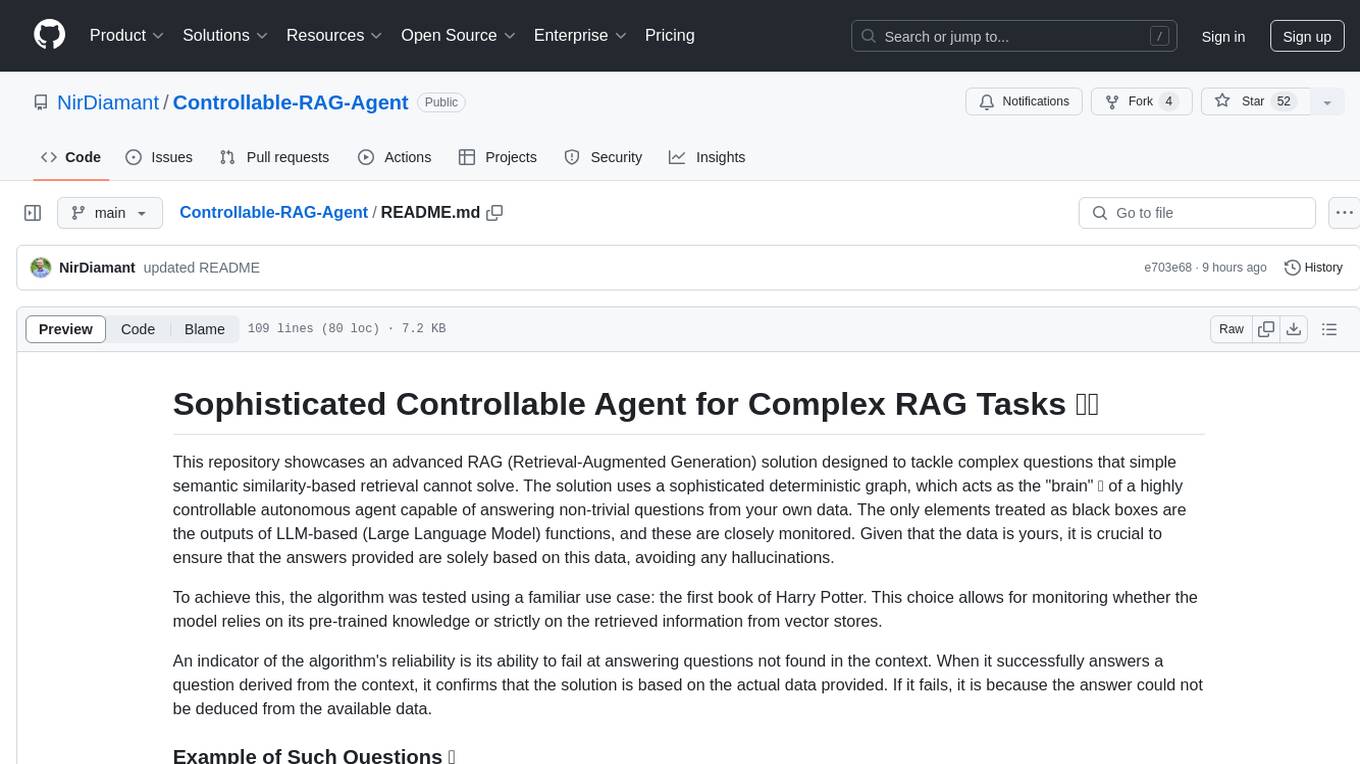
Controllable-RAG-Agent
This repository contains a sophisticated deterministic graph-based solution for answering complex questions using a controllable autonomous agent. The solution is designed to ensure that answers are solely based on the provided data, avoiding hallucinations. It involves various steps such as PDF loading, text preprocessing, summarization, database creation, encoding, and utilizing large language models. The algorithm follows a detailed workflow involving planning, retrieval, answering, replanning, content distillation, and performance evaluation. Heuristics and techniques implemented focus on content encoding, anonymizing questions, task breakdown, content distillation, chain of thought answering, verification, and model performance evaluation.
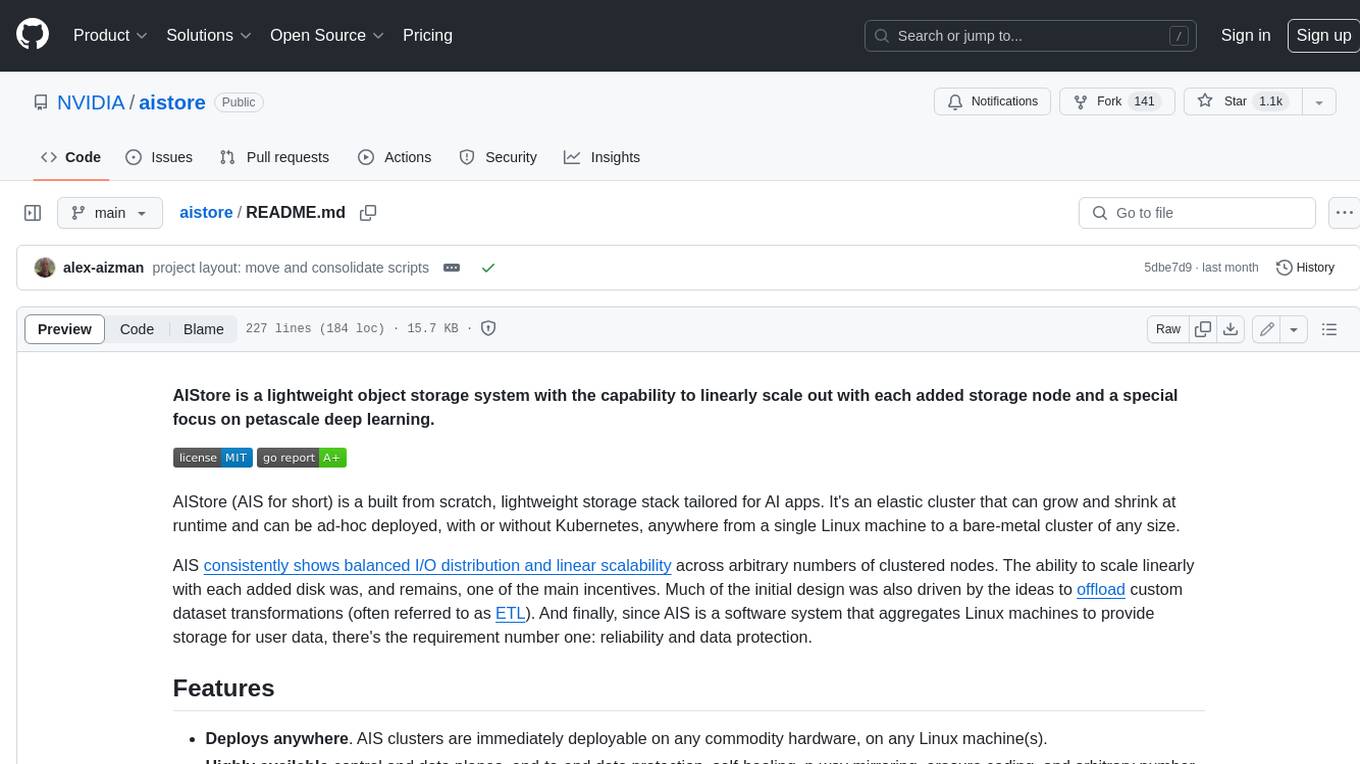
aistore
AIStore is a lightweight object storage system designed for AI applications. It is highly scalable, reliable, and easy to use. AIStore can be deployed on any commodity hardware, and it can be used to store and manage large datasets for deep learning and other AI applications.
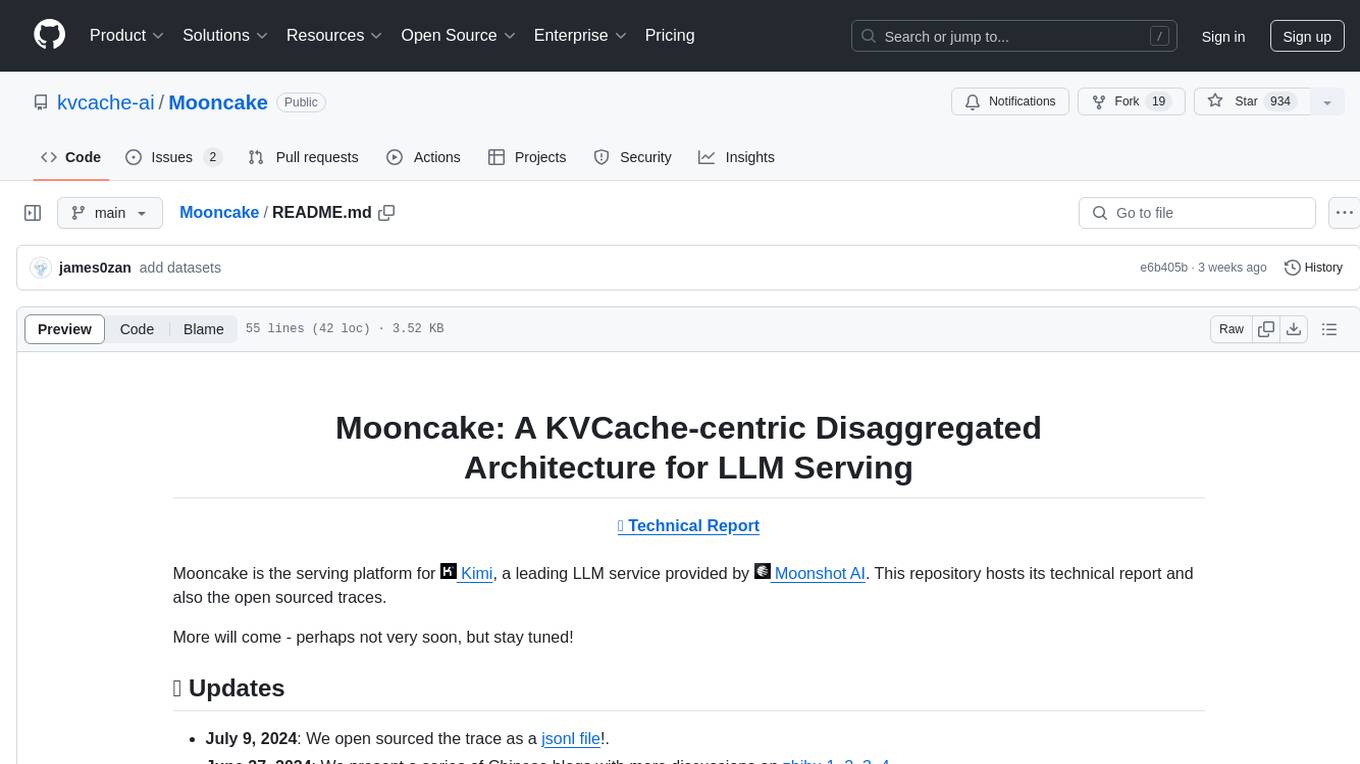
Mooncake
Mooncake is a serving platform for Kimi, a leading LLM service provided by Moonshot AI. It features a KVCache-centric disaggregated architecture that separates prefill and decoding clusters, leveraging underutilized CPU, DRAM, and SSD resources of the GPU cluster. Mooncake's scheduler balances throughput and latency-related SLOs, with a prediction-based early rejection policy for highly overloaded scenarios. It excels in long-context scenarios, achieving up to a 525% increase in throughput while handling 75% more requests under real workloads.
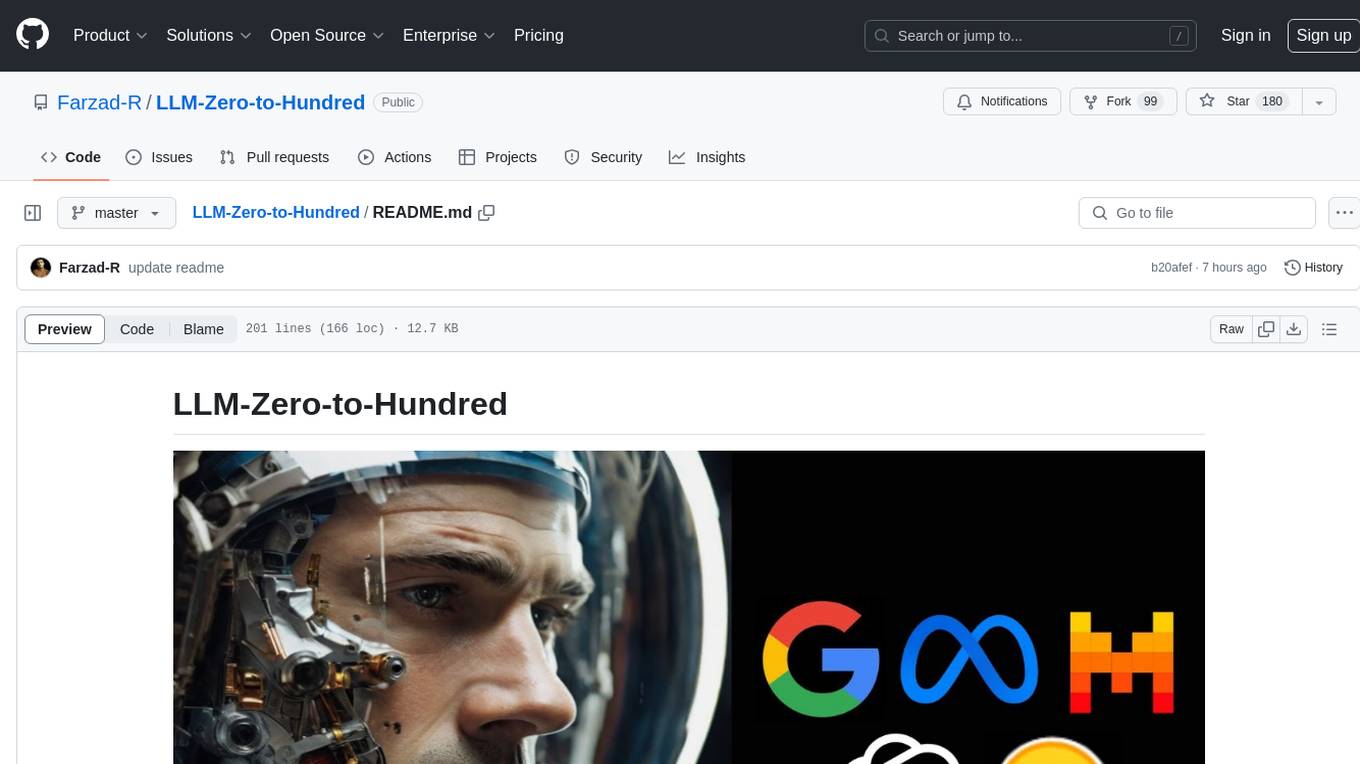
LLM-Zero-to-Hundred
LLM-Zero-to-Hundred is a repository showcasing various applications of LLM chatbots and providing insights into training and fine-tuning Language Models. It includes projects like WebGPT, RAG-GPT, WebRAGQuery, LLM Full Finetuning, RAG-Master LLamaindex vs Langchain, open-source-RAG-GEMMA, and HUMAIN: Advanced Multimodal, Multitask Chatbot. The projects cover features like ChatGPT-like interaction, RAG capabilities, image generation and understanding, DuckDuckGo integration, summarization, text and voice interaction, and memory access. Tutorials include LLM Function Calling and Visualizing Text Vectorization. The projects have a general structure with folders for README, HELPER, .env, configs, data, src, images, and utils.
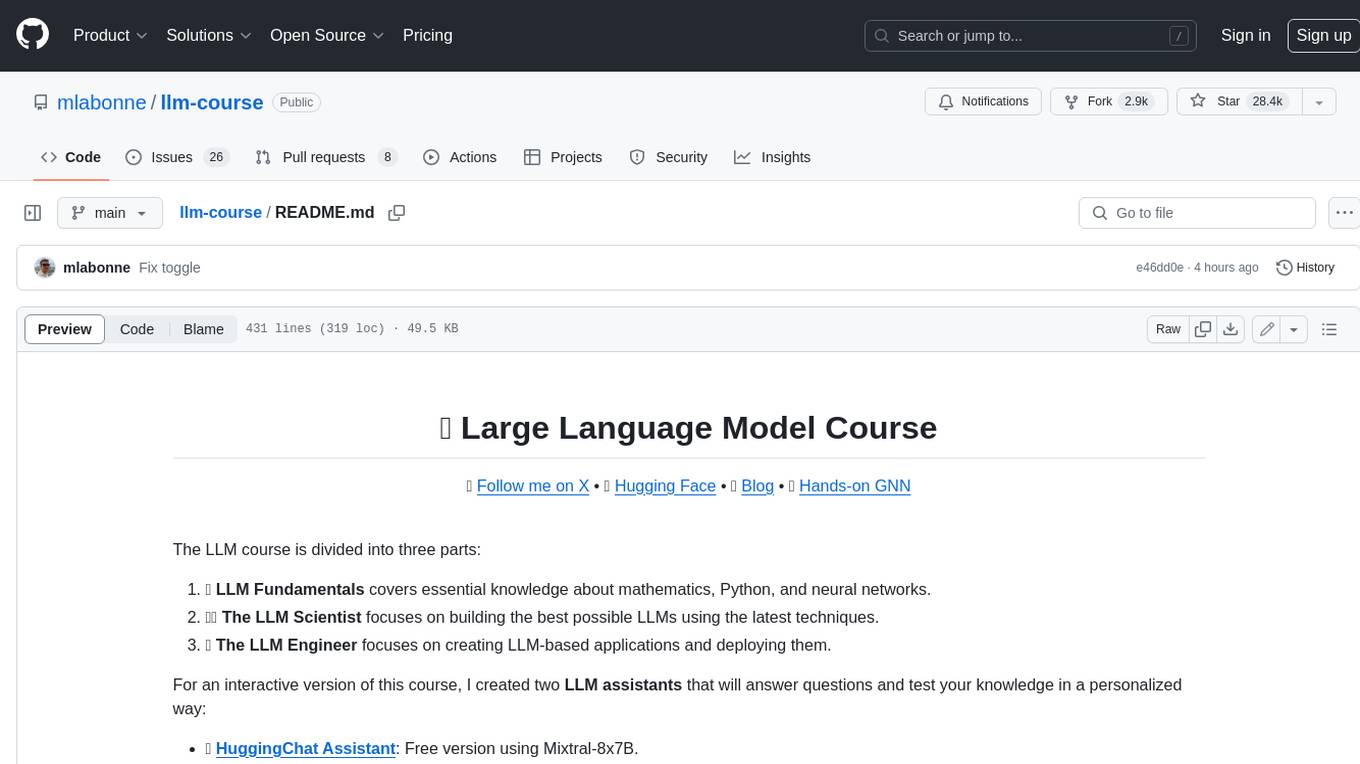
llm-course
The LLM course is divided into three parts: 1. 🧩 **LLM Fundamentals** covers essential knowledge about mathematics, Python, and neural networks. 2. 🧑🔬 **The LLM Scientist** focuses on building the best possible LLMs using the latest techniques. 3. 👷 **The LLM Engineer** focuses on creating LLM-based applications and deploying them. For an interactive version of this course, I created two **LLM assistants** that will answer questions and test your knowledge in a personalized way: * 🤗 **HuggingChat Assistant**: Free version using Mixtral-8x7B. * 🤖 **ChatGPT Assistant**: Requires a premium account. ## 📝 Notebooks A list of notebooks and articles related to large language models. ### Tools | Notebook | Description | Notebook | |----------|-------------|----------| | 🧐 LLM AutoEval | Automatically evaluate your LLMs using RunPod |  | | 🥱 LazyMergekit | Easily merge models using MergeKit in one click. |  | | 🦎 LazyAxolotl | Fine-tune models in the cloud using Axolotl in one click. |  | | ⚡ AutoQuant | Quantize LLMs in GGUF, GPTQ, EXL2, AWQ, and HQQ formats in one click. |  | | 🌳 Model Family Tree | Visualize the family tree of merged models. |  | | 🚀 ZeroSpace | Automatically create a Gradio chat interface using a free ZeroGPU. |  |
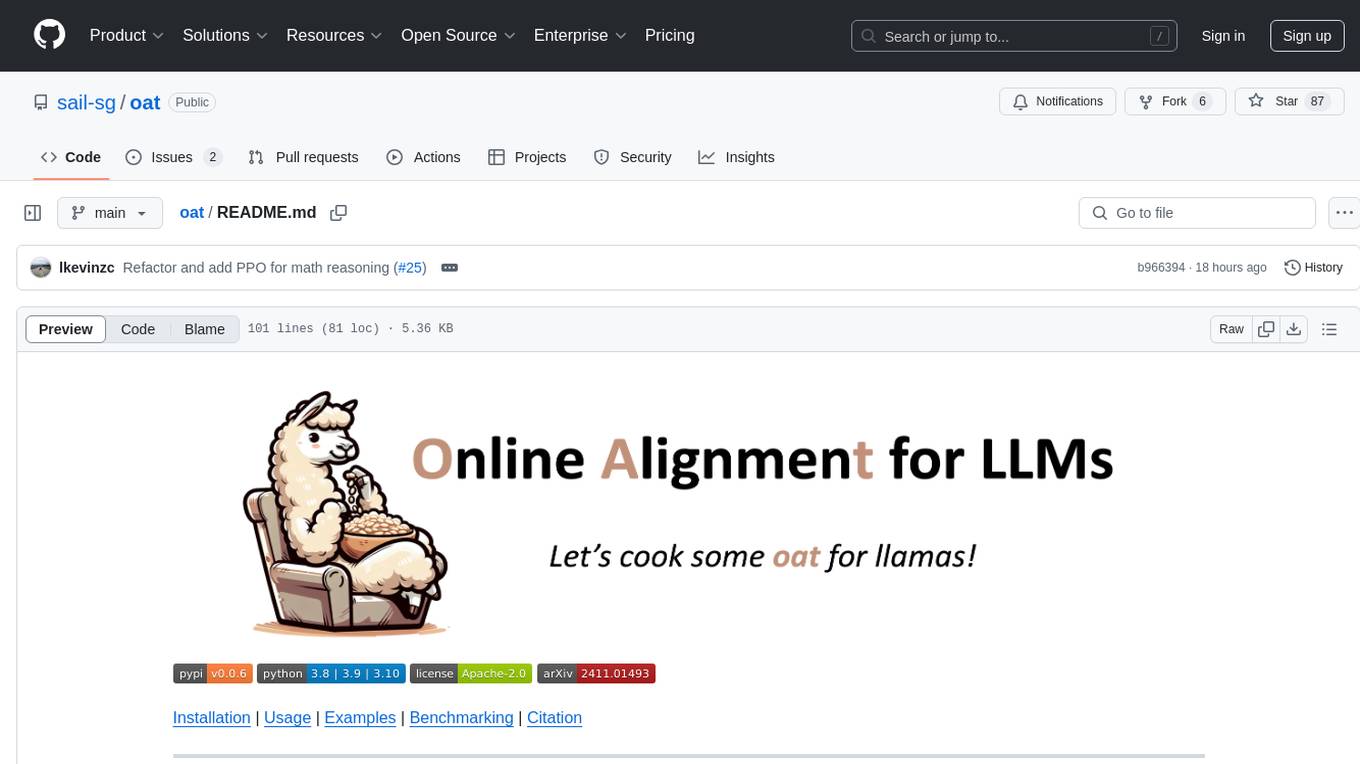
oat
Oat is a simple and efficient framework for running online LLM alignment algorithms. It implements a distributed Actor-Learner-Oracle architecture, with components optimized using state-of-the-art tools. Oat simplifies the experimental pipeline of LLM alignment by serving an Oracle online for preference data labeling and model evaluation. It provides a variety of oracles for simulating feedback and supports verifiable rewards. Oat's modular structure allows for easy inheritance and modification of classes, enabling rapid prototyping and experimentation with new algorithms. The framework implements cutting-edge online algorithms like PPO for math reasoning and various online exploration algorithms.
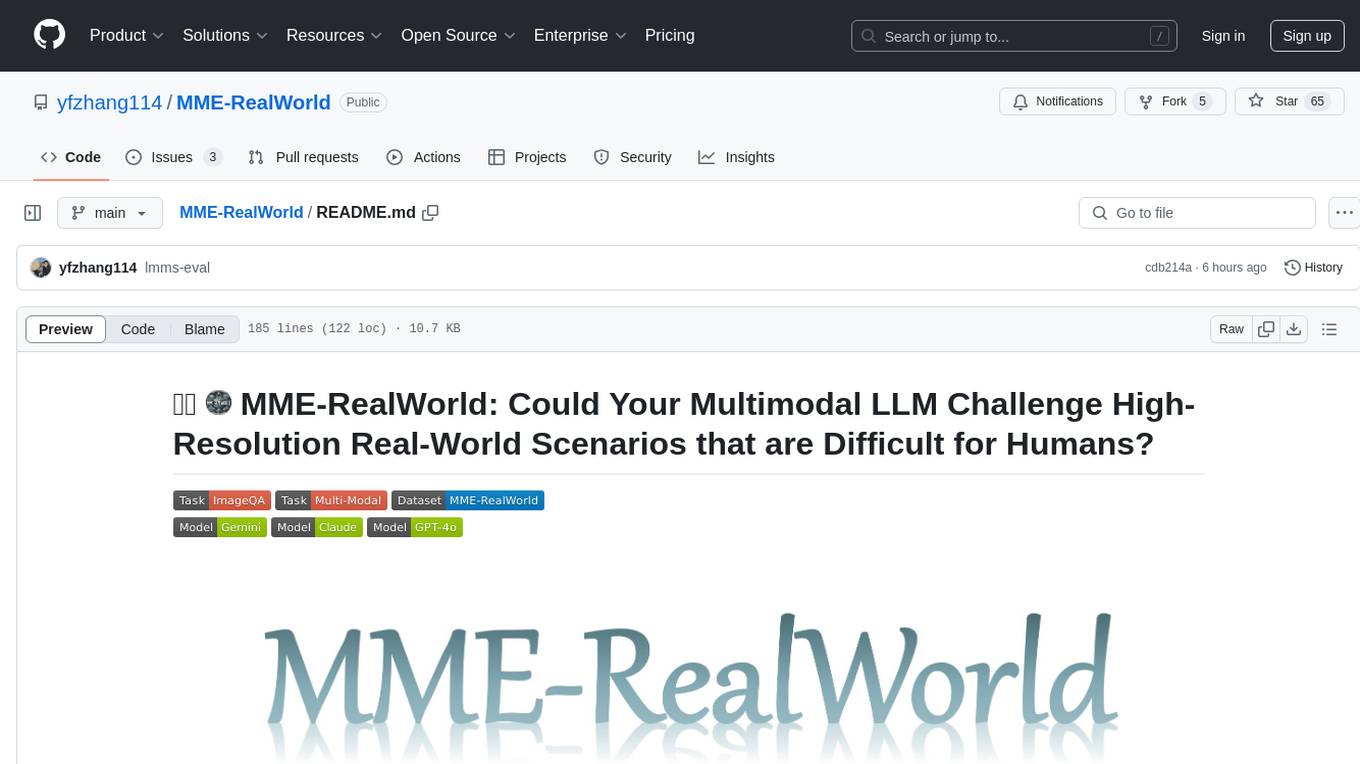
MME-RealWorld
MME-RealWorld is a benchmark designed to address real-world applications with practical relevance, featuring 13,366 high-resolution images and 29,429 annotations across 43 tasks. It aims to provide substantial recognition challenges and overcome common barriers in existing Multimodal Large Language Model benchmarks, such as small data scale, restricted data quality, and insufficient task difficulty. The dataset offers advantages in data scale, data quality, task difficulty, and real-world utility compared to existing benchmarks. It also includes a Chinese version with additional images and QA pairs focused on Chinese scenarios.
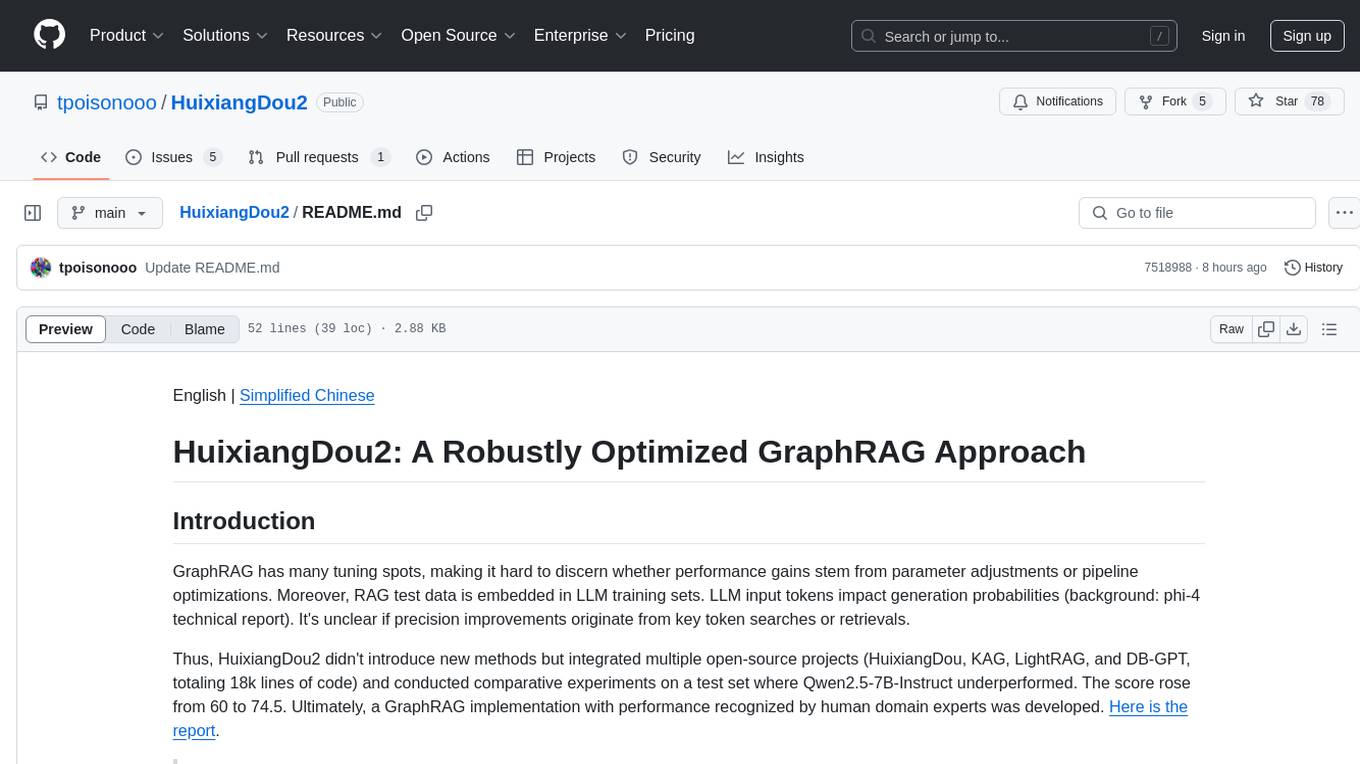
HuixiangDou2
HuixiangDou2 is a robustly optimized GraphRAG approach that integrates multiple open-source projects to improve performance in graph-based augmented generation. It conducts comparative experiments and achieves a significant score increase, leading to a GraphRAG implementation with recognized performance. The repository provides code improvements, dense retrieval for querying entities and relationships, real domain knowledge testing, and impact analysis on accuracy.
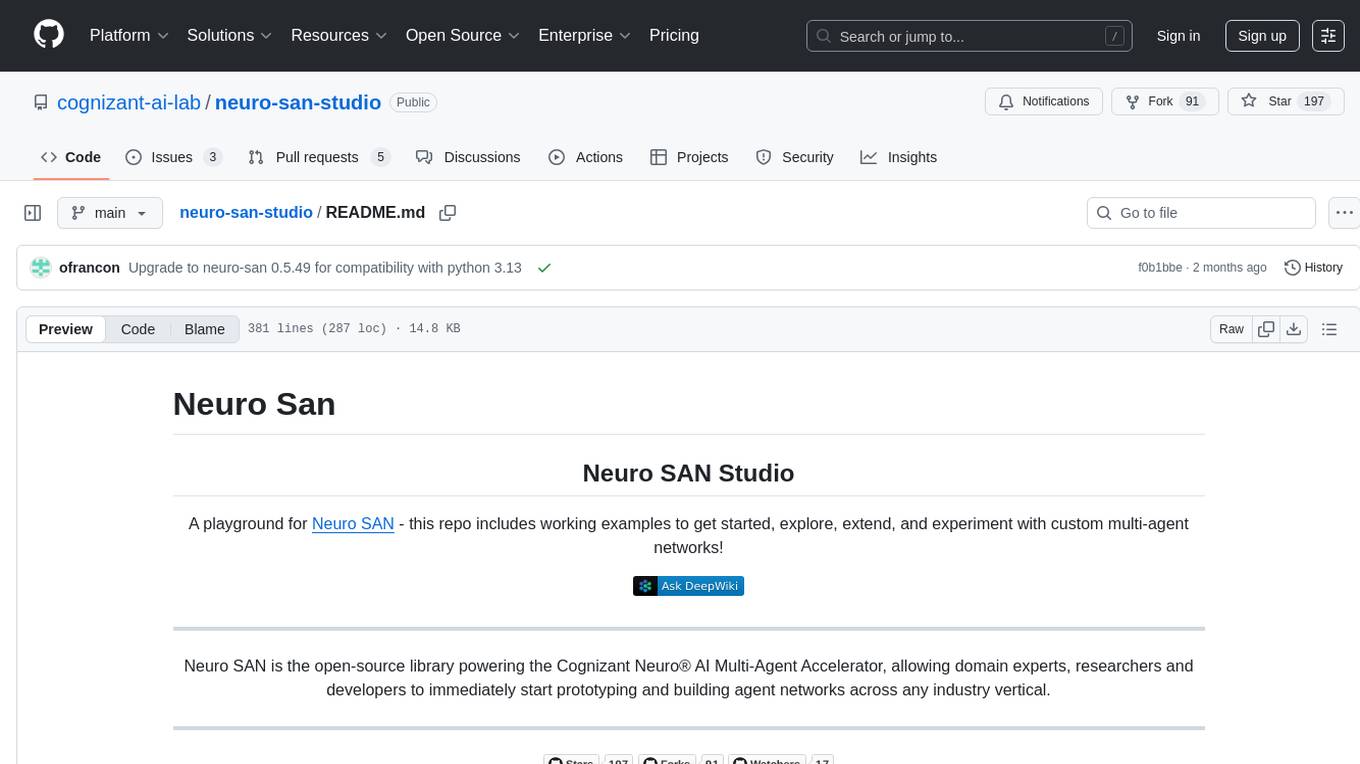
neuro-san-studio
Neuro SAN Studio is an open-source library for building agent networks across various industries. It simplifies the development of collaborative AI systems by enabling users to create sophisticated multi-agent applications using declarative configuration files. The tool offers features like data-driven configuration, adaptive communication protocols, safe data handling, dynamic agent network designer, flexible tool integration, robust traceability, and cloud-agnostic deployment. It has been used in various use-cases such as automated generation of multi-agent configurations, airline policy assistance, banking operations, market analysis in consumer packaged goods, insurance claims processing, intranet knowledge management, retail operations, telco network support, therapy vignette supervision, and more.
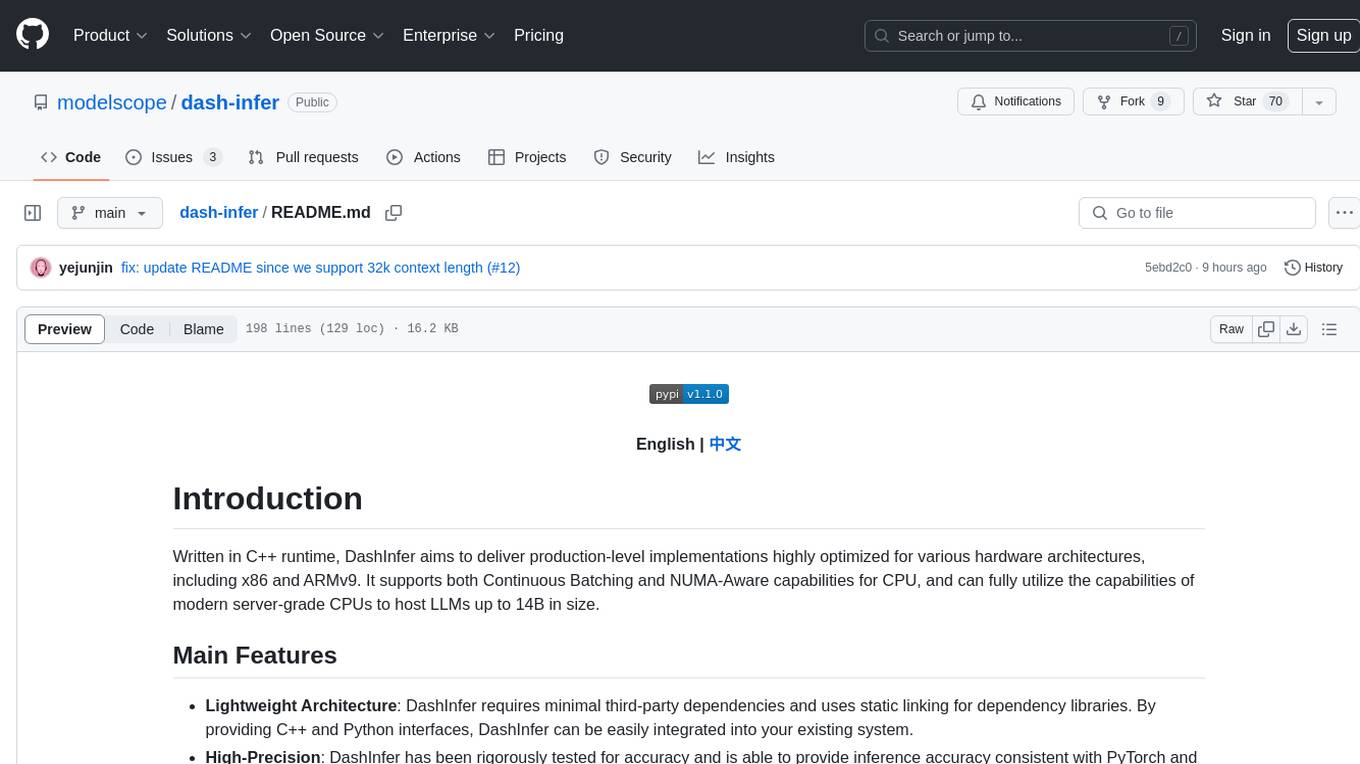
dash-infer
DashInfer is a C++ runtime tool designed to deliver production-level implementations highly optimized for various hardware architectures, including x86 and ARMv9. It supports Continuous Batching and NUMA-Aware capabilities for CPU, and can fully utilize modern server-grade CPUs to host large language models (LLMs) up to 14B in size. With lightweight architecture, high precision, support for mainstream open-source LLMs, post-training quantization, optimized computation kernels, NUMA-aware design, and multi-language API interfaces, DashInfer provides a versatile solution for efficient inference tasks. It supports x86 CPUs with AVX2 instruction set and ARMv9 CPUs with SVE instruction set, along with various data types like FP32, BF16, and InstantQuant. DashInfer also offers single-NUMA and multi-NUMA architectures for model inference, with detailed performance tests and inference accuracy evaluations available. The tool is supported on mainstream Linux server operating systems and provides documentation and examples for easy integration and usage.
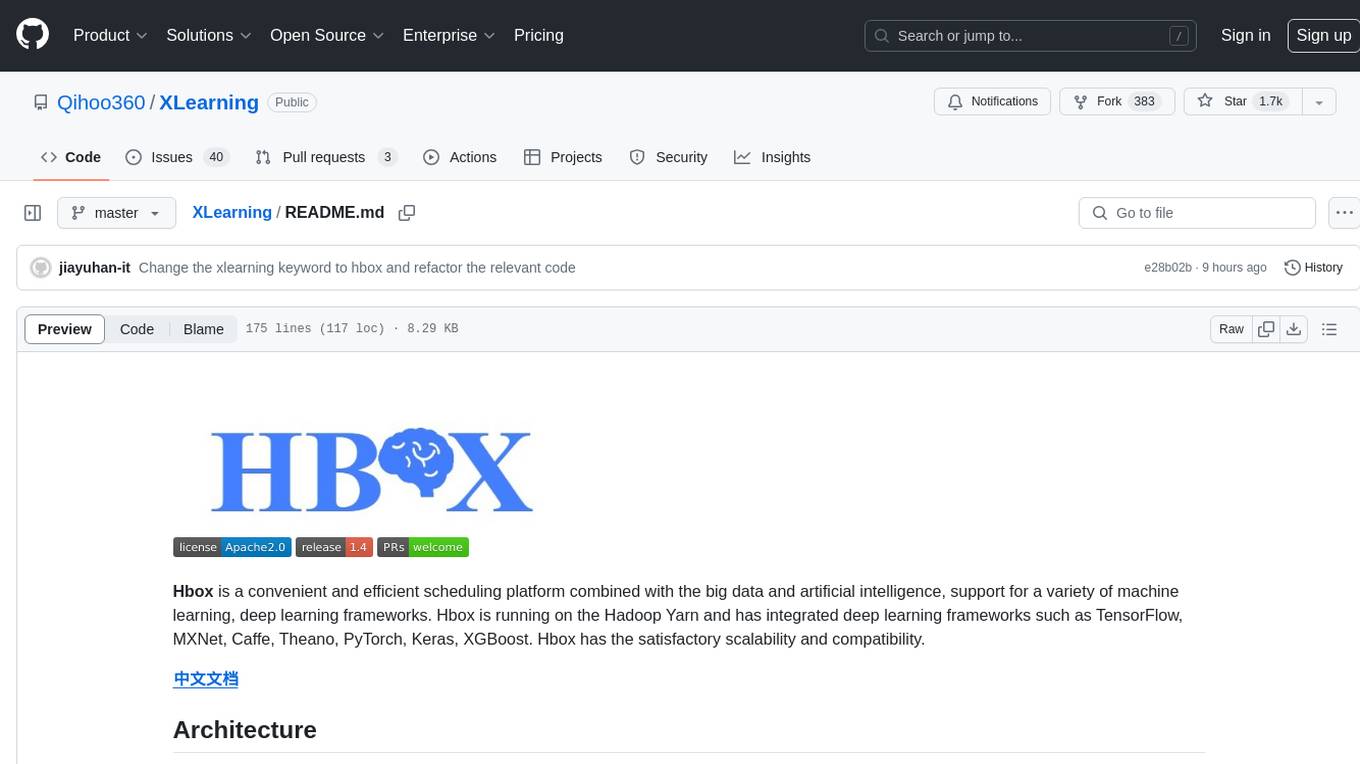
XLearning
XLearning is a scheduling platform for big data and artificial intelligence, supporting various machine learning and deep learning frameworks. It runs on Hadoop Yarn and integrates frameworks like TensorFlow, MXNet, Caffe, Theano, PyTorch, Keras, XGBoost. XLearning offers scalability, compatibility, multiple deep learning framework support, unified data management based on HDFS, visualization display, and compatibility with code at native frameworks. It provides functions for data input/output strategies, container management, TensorBoard service, and resource usage metrics display. XLearning requires JDK >= 1.7 and Maven >= 3.3 for compilation, and deployment on CentOS 7.2 with Java >= 1.7 and Hadoop 2.6, 2.7, 2.8.
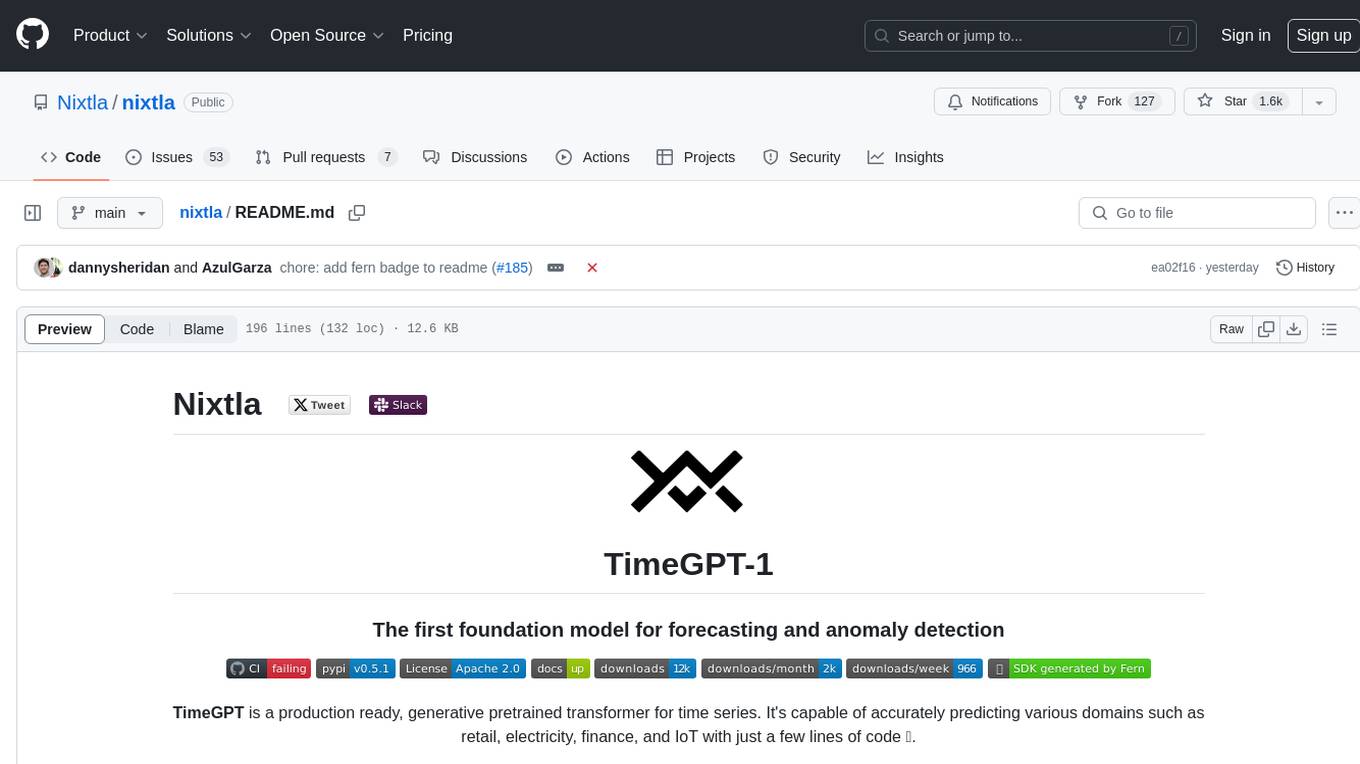
nixtla
Nixtla is a production-ready generative pretrained transformer for time series forecasting and anomaly detection. It can accurately predict various domains such as retail, electricity, finance, and IoT with just a few lines of code. TimeGPT introduces a paradigm shift with its standout performance, efficiency, and simplicity, making it accessible even to users with minimal coding experience. The model is based on self-attention and is independently trained on a vast time series dataset to minimize forecasting error. It offers features like zero-shot inference, fine-tuning, API access, adding exogenous variables, multiple series forecasting, custom loss function, cross-validation, prediction intervals, and handling irregular timestamps.
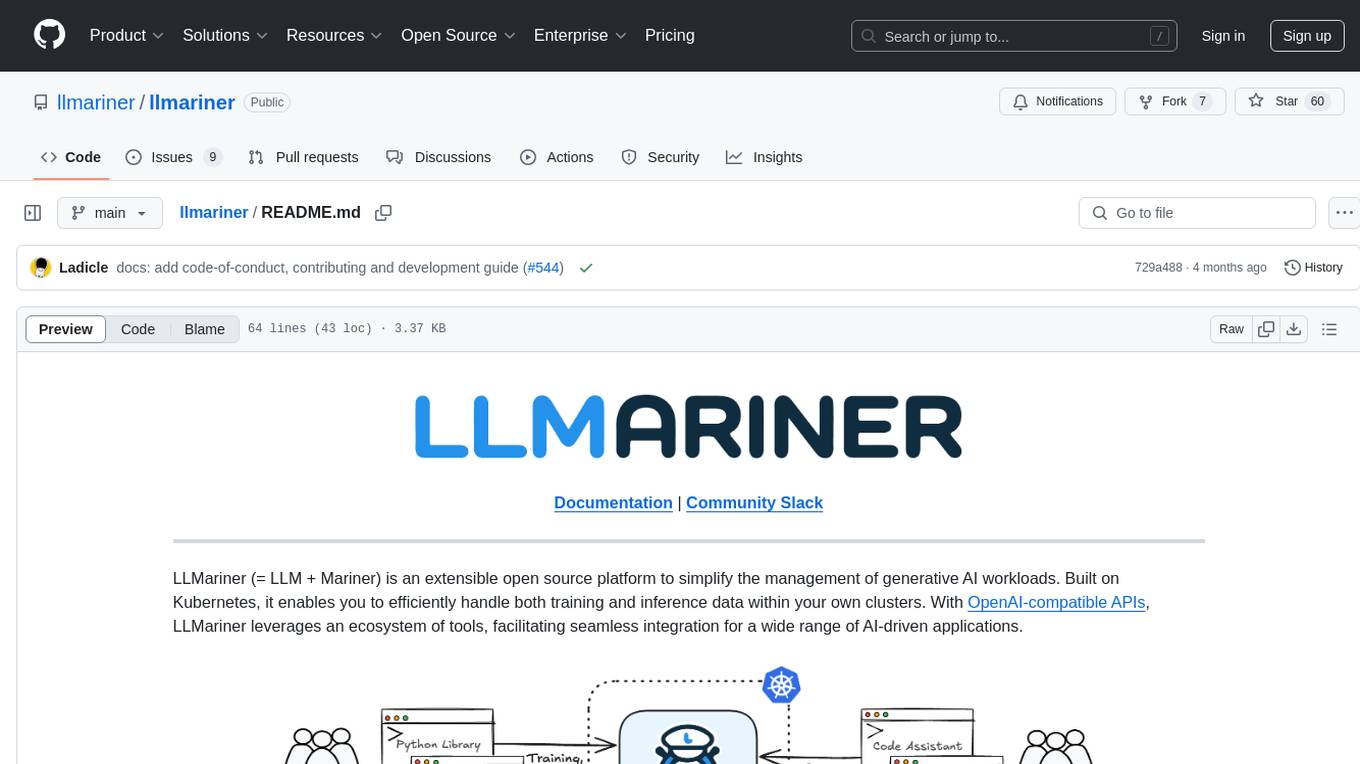
llmariner
LLMariner is an extensible open source platform built on Kubernetes to simplify the management of generative AI workloads. It enables efficient handling of training and inference data within clusters, with OpenAI-compatible APIs for seamless integration with a wide range of AI-driven applications.

LinguaHaru
Next-generation AI translation tool that provides high-quality, precise translations for various common file formats with a single click. It is based on cutting-edge large language models, offering exceptional translation quality with minimal operation, supporting multiple document formats and languages. Features include multi-format compatibility, global language translation, one-click rapid translation, flexible translation engines, and LAN sharing for efficient collaborative work.
For similar tasks

CogVideo
CogVideo is an open-source repository that provides pretrained text-to-video models for generating videos based on input text. It includes models like CogVideoX-2B and CogVideo, offering powerful video generation capabilities. The repository offers tools for inference, fine-tuning, and model conversion, along with demos showcasing the model's capabilities through CLI, web UI, and online experiences. CogVideo aims to facilitate the creation of high-quality videos from textual descriptions, catering to a wide range of applications.
For similar jobs

weave
Weave is a toolkit for developing Generative AI applications, built by Weights & Biases. With Weave, you can log and debug language model inputs, outputs, and traces; build rigorous, apples-to-apples evaluations for language model use cases; and organize all the information generated across the LLM workflow, from experimentation to evaluations to production. Weave aims to bring rigor, best-practices, and composability to the inherently experimental process of developing Generative AI software, without introducing cognitive overhead.

LLMStack
LLMStack is a no-code platform for building generative AI agents, workflows, and chatbots. It allows users to connect their own data, internal tools, and GPT-powered models without any coding experience. LLMStack can be deployed to the cloud or on-premise and can be accessed via HTTP API or triggered from Slack or Discord.

VisionCraft
The VisionCraft API is a free API for using over 100 different AI models. From images to sound.

kaito
Kaito is an operator that automates the AI/ML inference model deployment in a Kubernetes cluster. It manages large model files using container images, avoids tuning deployment parameters to fit GPU hardware by providing preset configurations, auto-provisions GPU nodes based on model requirements, and hosts large model images in the public Microsoft Container Registry (MCR) if the license allows. Using Kaito, the workflow of onboarding large AI inference models in Kubernetes is largely simplified.

PyRIT
PyRIT is an open access automation framework designed to empower security professionals and ML engineers to red team foundation models and their applications. It automates AI Red Teaming tasks to allow operators to focus on more complicated and time-consuming tasks and can also identify security harms such as misuse (e.g., malware generation, jailbreaking), and privacy harms (e.g., identity theft). The goal is to allow researchers to have a baseline of how well their model and entire inference pipeline is doing against different harm categories and to be able to compare that baseline to future iterations of their model. This allows them to have empirical data on how well their model is doing today, and detect any degradation of performance based on future improvements.

tabby
Tabby is a self-hosted AI coding assistant, offering an open-source and on-premises alternative to GitHub Copilot. It boasts several key features: * Self-contained, with no need for a DBMS or cloud service. * OpenAPI interface, easy to integrate with existing infrastructure (e.g Cloud IDE). * Supports consumer-grade GPUs.

spear
SPEAR (Simulator for Photorealistic Embodied AI Research) is a powerful tool for training embodied agents. It features 300 unique virtual indoor environments with 2,566 unique rooms and 17,234 unique objects that can be manipulated individually. Each environment is designed by a professional artist and features detailed geometry, photorealistic materials, and a unique floor plan and object layout. SPEAR is implemented as Unreal Engine assets and provides an OpenAI Gym interface for interacting with the environments via Python.

Magick
Magick is a groundbreaking visual AIDE (Artificial Intelligence Development Environment) for no-code data pipelines and multimodal agents. Magick can connect to other services and comes with nodes and templates well-suited for intelligent agents, chatbots, complex reasoning systems and realistic characters.


